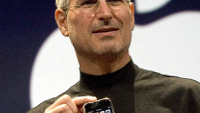Original Apple iPhone unveiling could have been a disaster

On this date two years ago, the world lost a forward thinking visionary when Steve Jobs succumbed to pancreatic cancer. In Saturday's New York Times, there are some excerpts from an upcoming book entitled Dogfight: How Apple and Google Went to War and Started a Revolution that go inside the first launch of the Apple iPhone. For example, the software in the Wi-Fi radio packed into the unit that Steve Jobs would introduce to the world, was unstable. As a result, wires had to be run off stage and connected to the phone's antennas so that the signal would not have to travel so far.
Even though AT&T had brought in a portable cell tower for the event, Steve Jobs had the iPhone that he would use in the unveiling, programmed to always show 5 bars of signal strength regardless of what the true reading was. Andy Grignon, the senior engineer responsible for the radios in the phone, was so nervous about the event that he packed on 50 pounds in the weeks before the launch. "If the radio crashed and restarted, as we suspected it might, we didn’t want people in the audience to see that, so we just hard-coded it to always show five bars," Grignon recalled.
But the biggest worry was that the demo iPhone would crash while Jobs was multitasking on stage. In case the unit he was working with ran out of memory, Apple's CEO had a few other units with him on stage that he could instantly switch to. The phones had just 128MB of memory and were prone to crashing. It seems hard to believe now, but one of the greatest consumer products ever launched was far from complete on that January day in 2007 when it was unveiled. Not one unit ever came off an assembly line, and the 100 or so units built before the introduction of the device had plenty of faults. The software was buggy and the device couldn't even finish playing one song or video without crashing. Send an email and browse the internet and the phone would work. Reverse the order and it would crash. The challenge for Steve Jobs was to show a smooth running phone at the unveiling, make the public drool now, and hammer out the bugs over the 6 months before the phone was actually launched.
Jobs had to be feeling nervous. If you view a video of his introduction of the Motorola E790 iTunes phone (aka ROKR E1), a glitch during the presentation made Jobs look lost and you could see him getting annoyed on stage. Ironically, Apple almost purchased Motorola in 2003, but at the time it was considered a company too big for Apple to swallow. Even more ironically, Google bought out the handset maker eight years after Apple failed to do so.
Things fell into place as Apple worked on the software that became iOS. Multitouch, which by 2003 could be used on a tablet like prototype, was introduced to the public with the new touchscreen phone. Despite this, the first prototype was similar to an iPod with a click wheel for dialing. Another prototype looked more like the device we know as the first-gen iPhone. But constructed of brushed aluminum, the radio signals could not escape the inside of the phone.


source: NYTimes
Things fell into place as Apple worked on the software that became iOS. Multitouch, which by 2003 could be used on a tablet like prototype, was introduced to the public with the new touchscreen phone. Despite this, the first prototype was similar to an iPod with a click wheel for dialing. Another prototype looked more like the device we know as the first-gen iPhone. But constructed of brushed aluminum, the radio signals could not escape the inside of the phone.
Security was tight. Apple didn't even tell the companies whose parts were driving the phone what it was building. Companies like Marvell, which produced the Wi-Fi chip, thought that its part was going into a new iPod. Phony schematics were drawn up to throw people off the scent. Amid some rumors about an Apple manufactured handset, the Apple iPhone was finally introduced on January 9th, 2007 and the world was changed. Not that the engineers who worked on the project realized what they had unleashed on the world. Fortified from a flask smuggled in during the event, they were all feeling no pain.


source: NYTimes
Follow us on Google News













Things that are NOT allowed:
To help keep our community safe and free from spam, we apply temporary limits to newly created accounts: